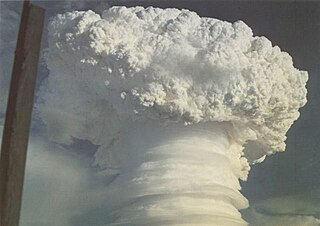
Little Boy was the name of the atomic bomb dropped on the Japanese city of Hiroshima on 6 August 1945 during World War II, making it the first nuclear weapon used in warfare. The bomb was dropped by the Boeing B-29 Superfortress Enola Gay piloted by Colonel Paul W. Tibbets Jr., commander of the 509th Composite Group, and Captain Robert A. Lewis. It exploded with an energy of approximately 15 kilotons of TNT (63 TJ) and caused widespread death and destruction throughout the city. The Hiroshima bombing was the second nuclear explosion in history, after the Trinity nuclear test.

A bomb is an explosive weapon that uses the exothermic reaction of an explosive material to provide an extremely sudden and violent release of energy. Detonations inflict damage principally through ground- and atmosphere-transmitted mechanical stress, the impact and penetration of pressure-driven projectiles, pressure damage, and explosion-generated effects. Bombs have been utilized since the 11th century starting in East Asia.

Nuclear fallout is the residual radioactive material propelled into the upper atmosphere following a nuclear blast, so called because it "falls out" of the sky after the explosion and the shock wave has passed. It commonly refers to the radioactive dust and ash created when a nuclear weapon explodes. The amount and spread of fallout is a product of the size of the weapon and the altitude at which it is detonated. Fallout may get entrained with the products of a pyrocumulus cloud and fall as black rain. This radioactive dust, usually consisting of fission products mixed with bystanding atoms that are neutron-activated by exposure, is a form of radioactive contamination.

A nuclear bunker buster, also known as an earth-penetrating weapon (EPW), is the nuclear equivalent of the conventional bunker buster. The non-nuclear component of the weapon is designed to penetrate soil, rock, or concrete to deliver a nuclear warhead to an underground target. These weapons would be used to destroy hardened, underground military bunkers or other below-ground facilities. An underground explosion releases a larger fraction of its energy into the ground, compared to a surface burst or air burst explosion at or above the surface, and so can destroy an underground target using a lower explosive yield. This in turn could lead to a reduced amount of radioactive fallout. However, it is unlikely that the explosion would be completely contained underground. As a result, significant amounts of rock and soil would be rendered radioactive and lofted as dust or vapor into the atmosphere, generating significant fallout.

Operation Crossroads was a pair of nuclear weapon tests conducted by the United States at Bikini Atoll in mid-1946. They were the first nuclear weapon tests since Trinity in July 1945, and the first detonations of nuclear devices since the atomic bombing of Nagasaki on August 9, 1945. The purpose of the tests was to investigate the effect of nuclear weapons on warships.

Operation Ivy was the eighth series of American nuclear tests, coming after Tumbler-Snapper and before Upshot–Knothole. The two explosions were staged in late 1952 at Enewetak Atoll in the Pacific Proving Ground in the Marshall Islands.

The effects of a nuclear explosion on its immediate vicinity are typically much more destructive and multifaceted than those caused by conventional explosives. In most cases, the energy released from a nuclear weapon detonated within the lower atmosphere can be approximately divided into four basic categories:

A mushroom cloud is a distinctive mushroom-shaped flammagenitus cloud of debris, smoke, and usually condensed water vapor resulting from a large explosion. The effect is most commonly associated with a nuclear explosion, but any sufficiently energetic detonation or deflagration will produce the same effect. They can be caused by powerful conventional weapons, like thermobaric weapons such as the ATBIP and GBU-43/B MOAB. Some volcanic eruptions and impact events can produce natural mushroom clouds.

"Duck and cover" is a method of personal protection against the effects of a nuclear explosion. Ducking and covering is useful in offering a degree of protection to personnel located outside the radius of the nuclear fireball but still within sufficient range of the nuclear explosion that standing upright and uncovered is likely to cause serious injury or death. In the most literal interpretation, the focus of the maneuver is primarily on protective actions one can take during the first few crucial seconds-to-minutes after the event, while the film of the same name and a full encompassing of the advice also cater to providing protection up to weeks after the event.

Operation Hardtack I was a series of 35 nuclear tests conducted by the United States from April 28 to August 18 in 1958 at the Pacific Proving Grounds. At the time of testing, the Operation Hardtack I test series included more nuclear detonations than the total of prior nuclear explosions in the Pacific Ocean. These tests followed the Project 58/58A series, which occurred from 1957 December 6 to 1958, March 14, and preceded the Operation Argus series, which took place in 1958 from August 27 to September 6.

Elugelab, or Elugelap, was an island, part of the Enewetak Atoll in the Marshall Islands. It was destroyed by the world's first true hydrogen bomb test on 1 November 1952, a test which was codenamed shot "Mike" of Operation Ivy. Prior to being destroyed, the island was described as "just another small naked island of the atoll".

An air burst or airburst is the detonation of an explosive device such as an anti-personnel artillery shell or a nuclear weapon in the air instead of on contact with the ground or target. The principal military advantage of an air burst over a ground burst is that the energy from the explosion is distributed more evenly over a wider area; however, the peak energy is lower at ground zero.
A rainout is the process of precipitation causing the removal of radioactive particles from the atmosphere onto the ground, creating nuclear fallout by rain. The rainclouds of the rainout are often formed by the particles of a nuclear explosion itself and because of this, the decontamination of rainout is more difficult than a "dry" fallout.

Operation Tumbler–Snapper was a series of nuclear weapons tests conducted by the United States in early 1952 at the Nevada Test Site. The Tumbler–Snapper series of tests followed Operation Buster–Jangle and preceded Operation Ivy.
An underwater explosion is a chemical or nuclear explosion that occurs under the surface of a body of water. While useful in anti-ship and submarine warfare, underwater bombs are not as effective against coastal facilities.
The earthquake bomb, or seismic bomb, was a concept that was invented by the British aeronautical engineer Barnes Wallis early in World War II and subsequently developed and used during the war against strategic targets in Europe. A seismic bomb differs somewhat in concept from traditional bombs, which usually explode at or near the surface, and destroy their target directly by explosive force. In contrast, a seismic bomb is dropped from high altitude to attain very high speed as it falls and upon impact, penetrates and explodes deep underground, causing massive caverns or craters known as camouflets, as well as intense shockwaves. In this way, the seismic bomb can affect targets that are too massive to be affected by a conventional bomb, as well as damage or destroy difficult targets such as bridges and viaducts.

Underground nuclear testing is the test detonation of nuclear weapons that is performed underground. When the device being tested is buried at sufficient depth, the nuclear explosion may be contained, with no release of radioactive materials to the atmosphere.

Operation Sailor Hat was a series of explosives effects tests, conducted by the United States Navy Bureau of Ships under the sponsorship of the Defense Atomic Support Agency. The tests consisted of two underwater explosions at San Clemente Island, California in 1964 and three surface explosions at Kahoʻolawe, Hawaii in 1965. They were non-nuclear tests employing large quantities of conventional explosives to determine the effects of a nuclear weapon blast on naval vessels, and the first major test of this kind since Operation Crossroads in July 1946.

Operation Project 58/58A was a series of 4 nuclear tests conducted by the United States in 1957–1958 at the Nevada Test Site. These tests followed the Operation Plumbbob series and preceded the Operation Hardtack I series.

Nuclear testing at Bikini Atoll consisted of the detonation of 24 nuclear weapons by the United States between 1946 and 1958 on Bikini Atoll in the Marshall Islands. Tests occurred at 7 test sites on the reef itself, on the sea, in the air, and underwater. The test weapons produced a combined yield of 42.2 Mt of TNT in explosive power.
















